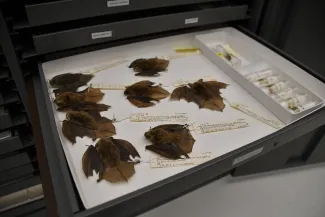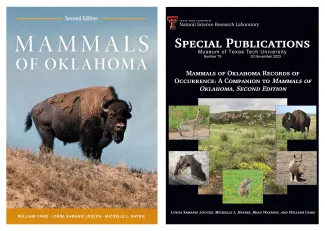When it comes to studying Oklahoma’s plants and animals, the most valuable lessons are assumed to be learned in the field by finding living specimens where they naturally occur and collecting all sorts of relevant measurements and observations. But treasure troves of data are also found after the field work has been completed, when researchers preserve and deposit physical evidence of their studies in one of the state’s natural history museums.
“The more records you have the better you understand the species, especially if there’s a change over time,” said Lynda Loucks, collections manager for the natural history museum at the University of Central Oklahoma, located in Edmond.
“Some of our specimens are more than 80 years old. We can pull the records to see when a specific plant flowered, what its measurements were, and then track that species through time to see what, if anything, has changed.”
Loucks works with a team of student workers and nine faculty members, each assigned to curate an individual collection, to manage an inventory of more than 90,000 specimens. In addition to the expected skins, dried flowers and vascular plants, feathers, and skulls, UCO’s collection also includes a number of fish transferred from the Oklahoma Water Resources Board; a unique lichen collection that includes nearly 300 Oklahoma species; and more than 40,000 owl pellets collected as part of a former Northeastern State University professor’s research.

A variety of bats have been preserved within the University of Central Oklahoma’s natural history museum. Each specimen has an identification tag that reveals important details like the individual’s standard measurements and the collection date and location.
“I think of a natural history collection as a library, but with specimens instead of books,” Loucks said.
And just as a library can dispense knowledge, so too can natural history museums.
The specimens within UCO’s collections have furthered learning through teaching, outreach, and research. The “teaching specimens” have been used to help students in at least 20 of the university’s forensic and natural science courses learn identification skills. “Outreach specimens” have traveled to local school groups and organizations to broaden public awareness of our natural resources. And the “research specimens” often come with additional data and have been used to confirm historic records. Teams have also revisited this research catalog and learned about the timing of a species’ development and reproduction or about changes in their distributions, publishing their findings in more than 100 scientific papers and reference materials.
“Even a partial piece of bone can be cataloged as a museum record. These physical collections and specimens are the best way for us to prove that a species occurs in Oklahoma.”
Oklahoma Records Shape Two New Mammal Reference Books
Loucks’ experience managing UCO’s 90,000-specimen collection has proved invaluable in a related assignment: tracking down and verifying the 36,290 known mammal specimens collected from Oklahoma and deposited in 50 natural history museums across the United States and Canada.
These verified records served as building blocks for the upcoming second edition of Mammals of Oklahoma, and its companion, a special publication listing the state’s mammal records of occurrence. The first reference book will provide species accounts of the state’s 117 species of mammals – describing the animal’s physical attributes, its habits, and documented collections within Oklahoma – while the second gives a county-by-county reckoning of the individual voucher specimens and the museums in which they now reside.

Did You Know?
Once compiled, the Mammals of Oklahoma Records of Occurrence revealed several fun facts and collection trends, including:
Thirteen of Oklahoma’s mammals are reported to have a statewide distribution, but only one species, the hispid cotton rat, has a voucher specimen – an archived sample with location data – recorded for each county.
Though lacking voucher specimens, two common game animals, the striped skunk and white-tailed deer, have been recorded in each county thanks to camera traps, hunting records, and roadkill documentation.
Cleveland County, home to the University of Oklahoma, has long been a collector’s paradise. It has the highest number of mammal voucher specimens within the state (2,640) and ties for the fourth highest number of collected mammal species (52, tied with McCurtain County). And Payne County, home to Oklahoma State University, has the third highest number of voucher specimens (2,109) and third highest number of collected species (54). Cimarron County, home to Black Mesa, has been another collection hotspot. This interface between the Mountain West and the Southern Great Plains has the second highest number of voucher specimens collected (2,431) and the highest number of collected species (65).
The second edition of Mammals of Oklahoma is currently available for pre-order by the University of Oklahoma Press for $75 and is expected in July 2024. (Look for the OU Press annual winter book sale for a discounted price.) The special publication of records of occurrences is available as a free digital copy and bound copies can be purchased from Texas Tech University for $20.
